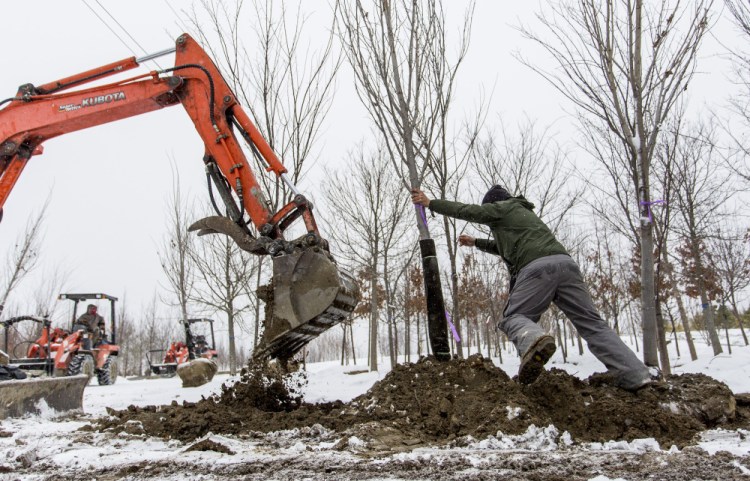Dale Pierson is worried.
For 40 years, the owner of Pierson Nurseries has been growing and selling plants at his 125-acre nursery in western Biddeford, and in recent weeks, after a stretch of warm weather, Pierson’s clients have started to show up, green thumbs itching.
“The weather is further ahead, and so are our customers,” he said, referring to the arrival of warmer temperatures after a relatively mild winter. “The grass is green, the frost is gone, people want to plant. So it was great to take advantage of getting further ahead this year, but I hope we don’t pay the price.”
That became a possibility when winter made a brief, blustery comeback Monday, with snow and record-setting cold reminding everyone that April can still be the cruelest month.
Temperatures dropped and snow blew across much of Cumberland and York counties Sunday and Monday. The temperature reached only 25 degrees at the Portland International Jetport as of 7 p.m. Monday and was on pace to break the record for the coldest high temperature on the date, 31 degrees on April 4, 1954.
The movements of the mercury mean more work for Pierson, who must keep his plants in balance as the spring temperatures fluctuate.
Allow too much warmth to build up below covered specimens during warm spells, and they risk growing too soon.
Keep a plant uncovered for too long overnight – especially on nights like Monday and Tuesday when temperatures are expected to dip into the teens – and gardeners of all stripes will be filling their compost bins with the casualties of weather.
“Everything’s helpful and everything’s a risk this year,” he said.
Covering and uncovering plants can only go so far, Pierson said.
“This is a big temperature switch,” he said. “There’s nothing we can do about 10 degrees colder than it should be out, or 15 or 20.”
Although Portland is only an hour south of Livermore, where Joel Gilbert grows apples, pears, peaches, cherries and other cash-crops at Berry Farm, the geography has helped blunt the temperature spikes that have the potential to disrupt the fruit tree budding process.
Had temperatures climbed in the 60s or 70s for a week or more with no freezing at night, the fruit trees would have started to “wake up” and bud – a disastrous turn if they are suddenly exposed to freezing temperatures.
That is exactly what happened in 2012, Gilbert said, and across the country, fruit growers could do nothing but watch their crops freeze and die on the vine.
“We had, like, 80-degree weather in March,” Gilbert recalled. “When flowering season came, we were right in the middle of frost and there was tremendous loss. We don’t like fluctuations. We like more consistent temperatures.”
It’s not only the flora that are hit hard by roller-coaster weather during this time of year.
Birds that migrate from Central America, South America and the West Indies are less accustomed to the cold than some species that migrate within the United States.
As much as the temperatures are a matter of concern, it is the snow’s impact on the birds’ food source that is most worrisome, said Doug Hitchcox, the staff naturalist for Maine Audubon Society.
Many bird species feed exclusively on insects that live in the ground, and snow or frost means birds must spend more time and energy eating to stay alive instead of protecting a territory or finding a mate, Hitchcox said.
Although the spring migration does not intensify until early May, some species, such as the American woodcock, are already here, and their survival could be strained if the snow that fell Monday sticks around for longer than a day or two.
“Even if the snow only lasts a day or two days, that’s not going to be terrible for them,” he said. “But if we got dumped with 6 inches and it look a week to go away, you’d certainly see more competition in those few open areas.”
Temperatures are expected to remain chilly through Tuesday, dipping into the teens again Tuesday night, but the weather is expected to climb into the 30s and 40s for the remainder of the week.
Send questions/comments to the editors.



